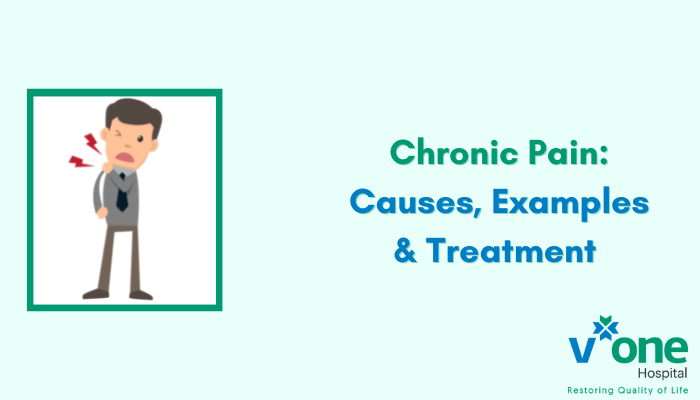Living With Chronic Pain – Causes, Symptoms and Treatment
Pain is a part of life. Everyone feels some kind of pain from time to time. When you nick yourself from shaving, fall down and bruise a knee, or you have been exercising for too long, it hurts, it is painful. But once the injury heals, life goes back to normal. But chronic pain is different. And when your body or any part of it keeps hurting for weeks, months, or even years on end, it’s difficult to not let it control the quality of your life.
What is Chronic Pain?
By definition, chronic pain is pain that lasts more than 3 months regardless of where it is in the body and whether it is continuous or comes and goes. Chronic pain can interfere with your daily activities and make it harder to work or have a social life, often leading to depression, anxiety, and insomnia.
How is Chronic Pain Different?
Injuries like skinned knees and broken bones cause acute pain, from which you recover as soon as the injury heals. But chronic pain can last long after you have recovered from an injury/illness, and can even happen for no obvious reason.
Symptoms of Chronic Pain
Chronic pain can manifest differently for everyone. People usually feel:
- Aching/ a dull ache
- Burning
- Shooting
- Squeezing
- Stiffness
- Stinging
- Throbbing
- Soreness
But there can also be:
- Fatigue
- Loss of appetite
- Weakness
- Lack of energy
- Mood changes
- Trouble sleeping
Living with chronic pain can lead to frustration and take a toll on your mental health and self-esteem. And depression and anxiety/stress can further exacerbate your pain, creating a cycle.
What Causes Chronic Pain?
More than 10 million Indians develop some kind of chronic pain every year. Sometimes, it’s because of a chronic illness like cancer or arthritis. Other times, it’s caused by an injury, like a back sprain or a pulled muscle. But the main culprit here is nerve damage. When you are injured, it activates the pain sensors, which send a message to your brain in the form of electrical signals traveling from nerve to nerve. The brain processes the signal and makes you realize that you are hurt. In the case of acute pain, when the cause is resolved, the signals stop. But with chronic pain, the nerve signals keep firing even after you have healed.
Chronic Pain Examples
Chronic pain can happen anywhere in the body. Usually, it manifests as:
- Headaches and migraines
- Cancer pain
- Arthritis pain
- Postsurgical pain
- Post-trauma pain
- Pain from nerve damage
- Lower back pain, neck pain
- Psychogenic/psychosomatic pain
- Infections
- Muscle pain from fibromyalgia
- Testicular pain
- Lasting pain in scar tissue
- Endometriosis pain
- Chronic Fatigue Syndrome
- Inflammatory Bowel Disease
- Interstitial Cystitis
- Vulvodynia
- Temporomandibular Joint Dysfunction
Managing Chronic Pain
As the name suggests, the pain is chronic. But that doesn’t mean that it always lasts forever. And it can be managed. The first choice is to identify and treat the cause, but sometimes, the cause is not known. Regardless, the primary goal of treatment is to reduce pain and improve mobility to restore a sense of normalcy.
The treatment approach depends on the type, cause, frequency, and severity of your pain, and your age and health. Usually, a combination of medications, therapies, and lifestyle changes is used.
Medication Used in Chronic Pain Management
The following medicines are used in managing chronic pain:
- Over-the-counter pain relievers
- Anticonvulsants for nerve pain (to prevent seizures)
- Antidepressants
- Corticosteroids
- Muscle relaxers
- Nonsteroidal Anti-Inflammatory Drugs (NSAIDs) or acetaminophen
- Adjuvant analgesics
- Topical products that are pain relievers or create soothing heat or cold
- Opioid pain relievers
- Medical marijuana
- Sedatives for anxiety/insomnia
Medical Procedures for Chronic Pain Management
Apart from medicines, these are available medical procedures for managing chronic pain:
- Transcutaneous Electrical Nerve Stimulation (TENS) can reduce pain by sending mild electric shocks to muscles through patches on your skin
- Nerve block injections can stop nerves from sending pain signals to the brain by injecting an anesthetic near the site of pain
- Acupuncture to reduce pain
- Surgery to correct injuries that may have healed improperly
- Epidural steroid injections work by injecting a steroid or corticosteroid (anti-inflammatory) near the spinal nerves
It’s important to note that these medical treatments can cause acute liver failure (from acetaminophen treatment), opioid addiction, mood changes, confusion, respiratory issues (from nerve pain medications), and spinal cord damage (from spinal cord stimulators).
Lifestyle Changes for Chronic Pain Management
Additionally, certain lifestyle changes can help improve the quality of life for someone with chronic pain:
- Physical therapy
- Psychotherapy (for example, CBT) to reduce stress
- Meditation
- Yoga
- Art and music therapy
- Massage
- Pet therapy
- Tai chi
- Getting enough exercise
- Getting enough sleep
- Eating a balanced diet that includes anti-inflammatory foods
- Quitting smoking
Chronic pain doesn’t have to be a death sentence. With a little support, it is possible to live a meaningful life.

